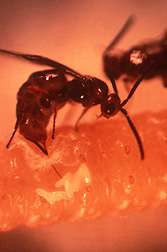Rearing technique may bolster biocontrol wasp's commercial prospects

Two to three millimeters long, the parasitoid wasp Habrobracon hebetor is a top candidate for use in programs to biologically control Indianmeal moths and other stored-product pests. But despite the prospects for reduced insecticide use and product losses, the approach has yet to gain traction commercially, in part because of the lack of an efficient method of stockpiling the wasp.
But a team of scientists, including researchers from the U.S. Department of Agriculture (USDA), is working on the problem.
Through studies of an insect-resting state called "reproductive diapause," the team determined that adult H. hebetor wasps can be conditioned to survive two months of storage at 41 degrees Fahrenheit and be revived without significant ill effects. According to James Throne of USDA's Agricultural Research Service (ARS), the-cold storage technique could give commercial insectaries greater flexibility in timing their wasp-rearing operations and minimize the expense of maintaining colonies of the insects until orders arrive.
ARS is USDA's chief intramural scientific research agency, and this research supports the USDA priority of promoting international food security.
H. hebetor wasps pose no threat to people, animals or crops. Instead, they seek out Indianmeal moth larvae and immobilize them with a paralyzing sting. The wasps then deposit eggs on the moth larvae. After hatching, the wasps' maggot-like brood suck juices from their hosts, killing them.
Studies with packaged commodities by scientists at the ARS Stored Product Insect Research Unit in Manhattan, Kan., indicate releasing the species can reduce Indianmeal moth populations by 71 percent—and by as much as 97 percent if combined with the wasp Trichogramma deion, which parasitizes the moth's eggs.
Such attacks also cut down on food contaminants that stored-product pests can leave behind, according to Throne, who collaborated with scientists from Kansas State University in Manhattan and Huazhong Agricultural University in China. Of the wasp-conditioning protocols they evaluated, the best combination seemed to be exposing the insects to temperatures of 68 degrees Fahrenheit and 10 hours of light daily.
The team published its findings in the June 2012 issue of Environmental Entomology.
Provided by United States Department of Agriculture


















